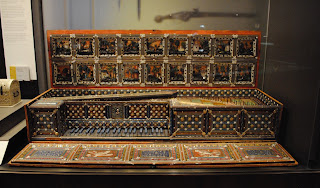On this trip to London I wanted to make sure I visited the British library. I had heard about it through friends who have visited and done research there. The only photography allowed is outside the
building, so I’m stuck with the one photo above.
The library is located near the King’s Cross/St. Pancras rail and tube stations. In order to keep a similar look of brick buildings as the rail station, this building was also built with bricks. It took 37 years of planning and construction to get a completed library building in 1997. The architect was Sir Colin St. John Wilson. There are 4 levels of basements that are used for storage and go 24 meters underground. There is another library/storage facility in Boston Spa (in West Yorkshire). It is possible to visit this location and do research there.
I took a tour of the library. It is well worth doing so. The cost was £10. An employee of the library showed us around and we were able to go to some areas where the general public is not allowed. One of these places was the scanning and transporting room. This is where the requested library items are scanned into the computer and placed on a conveyor belt to go to their final destination to be picked up by the library patron (usually to an assigned reading room based on the item’s subject area such as the humanities, social sciences, maps etc). The guide also spoke about the history of the library, the various rooms in the library and how you can get a reader pass to do research.
The main library in London (the one I visited) has exhibit rooms for rotating special exhibits (admission is charged) and rotating free exhibits. By rotating I mean that the exhibits change during
the year. I opted for the big free exhibit called “Treasures of the British Library”. It showcases some of the library’s special manuscripts. The original music manuscripts were especially of interest to me. It was fascinating to see the originals of music by Purcell, JS Bach, Mozart, Handel, Haydn, Beethoven, Mahler, Britten, Elgar, Schoenberg and Vaughan Williams. Each composer had his own style of writing out his music (neat or sloppy and some with handwritten comments in the margins and portions of the music crossed out). It was really interesting to recognize on paper pieces I have performed. In addition to music, there are manuscripts from literature, historical letters and religious books.
In addition to the exhibit rooms there are 11 reading rooms devoted to various areas such as maps,
Asian and African Studies, science, humanities, manuscripts, rare books and music, and a newsroom.
In order to look at materials in the library (and possibly check out certain items), you need to apply for a reader pass. It is a closed shelf system at this library. There are strict rules about what you can and cannot take into the reading rooms. You are allowed to photocopy or take pictures of the item you are researching, however there is a limit to how much of the item you can copy. They don’t want you copying the whole book.
There is a six story glass tower in the middle of the library that is home to the private collection of King George III (the mad king). This area is locked and accessible only to staff that are assigned to work in that tower. Many first editions of books are located there.
A Business Centre is also a key part of the library. There is a big collection of information on business and intellectual property to help you start, run and grow your business, protect your ideas and research your markets. It is possible to network there and make business contacts, as well as meet with advisors who can help direct your research and business projects. I imagine these services are used often by entrepreneurs.
There is a wing of the library devoted to the conservation of materials. When an item needs to be repaired, it comes here. This area is not open to the public, unless there is an advertised, library-sponsored event there.
In addition to visual materials, the library has a large collection of audio materials (recordings of music, speeches, interviews etc). You can get a taste of what they offer on the library’s website. Look for “sounds of the library”. You can listen to some recordings online without being a member of the library. I got stuck in the section of a reading of a children’s book by English speakers from various countries. I must admit I was disappointed by the section of regional American readers because the accents from various parts of the U.S. were not that distinct. For example the reading representative from the Boston area did not sound that different from the reader from Oklahoma. It was interesting for me to hear the various accents around the U.K., especially the Liverpool area.
I highly recommend a visit to the British Library. I spent hours there. If I ever want to do research, I would go there to do it. Apparently Johnny Depp does (for his movie roles).



















